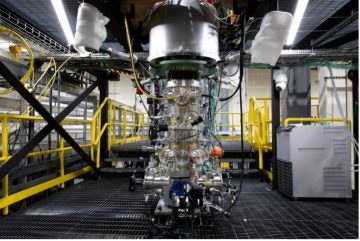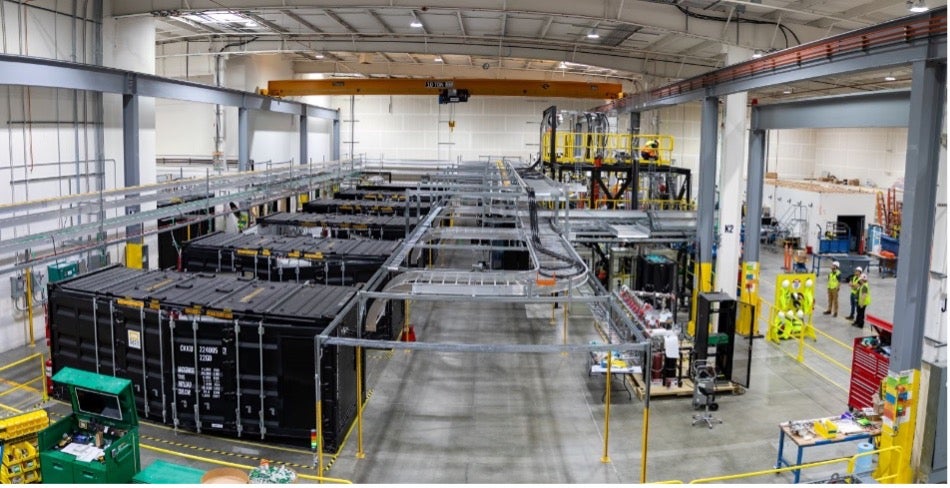
Zap Energy has begun operation of Century, its test platform for liquid metals and other key fusion energy technologies. The company said its total funding now surpasses $330m after it closed a $130m Series D funding round.
Zap Energy, based in Seattle, is building a low-cost, compact and scalable fusion energy platform that confines and compresses plasma without the need for expensive and complex magnetic coils. Zap said its sheared-flow-stabilised Z-pinch technology provides compelling fusion economics and requires orders of magnitude less capital than conventional approaches.
Century is Zap Energy’s first fully-integrated demonstration platform for three major plant-relevant technologies operating at up to 100 kW of input power. It is a high-rep-rate, liquid-metal-cooled fusion test platform, including one of the largest tests of a plasma-facing liquid metal blanket to date. Century has already demonstrated a test run of more than 1,000 consecutive plasmas in less than three hours into a chamber lined with flowing liquid metal.
The team is now attempting to reach a milestone outlined as part of the US Department of Energy’s (DOE’s) Milestone-Based Fusion Development Program, and hopes to achieve this by the end of the year.
“The race for fusion commercialisation has historically been thought of as a triathlon: science, then engineering, then commercialisation,” says Zap CEO Benj Conway. “But at Zap, we’re attempting to swim, cycle and run at the same time – such a parallel approach is key to delivering commercial fusion on a timescale that matters. Century is a vital part of the engineering leg and we’re quickly coming up to speed.”
To generate net energy from fusion, whatever device is used, the plasmas inside must be hot enough, dense enough, and last long enough. Zap Energy’s sheared-flow-stabilised Z pinch approach avoids large superconducting magnets and powerful lasers, and is far smaller than conventional systems.
With a track record of rapid progress in plasma physics using two workhorse fusion devices, and recent results reinforcing the viability of the path ahead, Zap has begun engineering new devices to face greater extremes and to harness fusion’s energy output.
“From its inception, Zap Energy’s founders had an idea of how a power plant based on our Z-pinch configuration would work,” said Zap Vice President of Systems Engineering Matthew C Thompson. “Our job is to develop and validate those plans by actually building, testing and maturing key technologies. Century is our next major step in that effort.” The goal is to integrate and test three major aspects of Zap’s power design: repetitive pulsed power supplies, plasma-facing circulating liquid metal walls, and technology for mitigating electrode damage.
Century is designed to simulate plant-like operation by:
- Firing high-voltage pulses of power every ten seconds in a steady sequence for more than two hours (>1,000 pulses at 0.1 Hz).
- Circulating 70 kilograms of hot liquid bismuth in its initial configuration and well over a tonne in its final configuration. Air-cooled heat exchangers will remove the intense plasma heat absorbed by the liquid metal.
- Testing critical strategies for mitigating electrode damage due to extreme heat and neutron flux.

“Zap’s fusion approach is pulsed, so ultimately it will run like an internal combustion engine with cylinders firing all day long to produce steady energy output,” Thompson explained. “As you do that you also generate large neutron flux and heat loads in the system over time, which is exactly the energy output that you want, but requires unique engineering solutions. Century will test a lot of our assumptions and define the best path toward our first plant.”
Zap’s power module designs have a circulating liquid metal wall to absorb heat and neutrons from the fusion plasmas. Century’s structure is the first to take Zap’s sheared-flow-stabilised Z-pinch chamber design and orient it vertically. This allows liquid metal to circulate out the bottom of the chamber. Pulsed power is injected through the top of the device while liquid metals circulate in a receptacle at the base. Independent test stands built over the past two years at Zap validated previous generations of each of Century’s subsystems.
The first test of plasmas and flowing liquid metal took place in June and a few weeks later completed a run of 1,080 consecutive shots. Century’s next aim is a milestone run for DOE, which will be subject to confirmation by the programme. Next year the platform will gradually ramp to 100 kilowatts of average input power.
Century, with a central stack about the size of a double-decker bus, is close to the eventual size of a single Zap Energy module that will produce 50 MWe. Future power plants are planned to have multiple modules.
Zap’s recent $130m Series D was led by Soros Fund Management, with participation by new investors that include BAM Elevate, Emerson Collective, Leitmotif, Mizuho Financial Group, Plynth Energy and Xplor Ventures. Current investors participating in the new round include Addition, Breakthrough Energy Ventures, Chevron Technology Ventures, DCVC, Energy Impact Partners, Lowercarbon Capital and Shell Ventures.
The new funding will be used to continue parallel development of both plasma R&D and systems-level plant engineering and integration, including the next generation in the company’s FuZE device series and a cutting-edge pulsed power capacitor bank.






